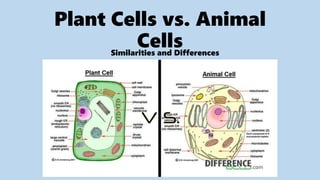
GRADE 11 WEEK 2 INTEGSCIWEEK2.pptx
- 1. Plant Cells vs. Animal Cells Similarities and Differences
- 2. Think – Pair – Share •Spend a minute or two discussing with the person next to you how a cell is similar to a small city.
- 3. Cell Analogy •Cells have a bunch of stuff inside of them that all have a certain role!
- 4. Organelles •Small parts within the cell •Each organelle has a specific, and different job to do in order to keep the cell alive
- 5. Remember… •Prokaryote •Simplest cells •Single-celled •Few, basic organelles •DNA floating around, uncontained •Eukaryote •Complex cells •Single or multi-celled •More organelles •DNA contained within the nucleus
- 8. Prokaryote or Eukaryote? •Are animal and plant cells prokaryote cells or eukaryote cells? •How do you know?
- 9. Eukaryote! • Plant and animals cells are both eukaryote cells as because they are multicellular and contain many organelles within each cell, including a nucleus where the DNA is stored.
- 10. How are they different? •We know plants and animals LOOK different, so how are their CELLS different?
- 11. Shapes of the cells •Plant cells are rectangular or boxy – regularly shaped •Animal cells are round or oval – irregular in shape
- 12. Structure of the cells •Only plant cells have a CELL WALL. •The CELL WALL provides the plant cell with SUPPORT. •Animal cells DO NOT have cell walls because they have skeletons that provide the support. I’m not found in plants!
- 13. Some Parts of the Cells •Chloroplast is ONLY found in PLANT cells. •Chloroplast produces food for the plant cell.
- 14. Certain Organelles •Chloroplast produces food by converting sunlight into sugar by the process called photosynthesis.
- 15. How are they the same? •We know plants and animals are both eukaryote cells, so they also have to have some similarities.
- 16. How are they the same? •Plant and animal cells are both eukaryotic cells.
- 17. Both have Nucleuses •The nucleus is the “brain” or information center of the cell •This is where the DNA hangs out •All eukaryotic cells have nucleus surrounded by nuclear membranes
- 18. Both have Cell Membranes •The cell membrane controls what gets in and out of the cell. •(But remember, the plant cell has a CELL WALL outside of the CELL MEMBRANE.
- 19. Both have Cytoplasm •Cytoplasm is the jelly-like substance within the cell where the organelles are positioned.
- 20. Both have Mitochondria •Mitochondria produce energy for the cells •The powerhouse of the cell
- 21. Both have Vacuoles…but… •Vacuoles store food and water in both plant and animal cells** •Vacuoles in PLANTS are much LARGER!!! •Why??? •(**Sometimes there more than one vacuoles or no vacuoles in animal cells…)
- 22. To Summarize… Plant Cells Animal Cells Shape – boxy or rectangular, regularly-shaped Shape – circular or round, irregularly-shaped
- 23. To Summarize… Plant Cells Animal Cells Shape – boxy or rectangular, regularly-shaped Shape – circular or round, irregularly-shaped Have a cell wall for support No cell wall (don’t need it because it has a skeleton!)
- 24. To Summarize… Plant Cells Animal Cells Shape – boxy or rectangular, regularly-shaped Shape – circular or round, irregularly-shaped Have a cell wall for support No cell wall (don’t need it because it has a skeleton!) Have chloroplasts to produce food through the process of photosynthesis No chloroplast – obtain food in other ways beside photosynthesis
- 25. To Summarize… Plant Cells Animal Cells Shape – boxy or rectangular, regularly-shaped Shape – circular or round, irregularly-shaped Have a cell wall for support No cell wall (don’t need it because it has a skeleton!) Have chloroplasts to produce food through the process of photosynthesis No chloroplast – obtain food in other ways beside photosynthesis (One) large vacuole Small (one or more) vacuoles (sometimes no vacuole)
- 26. Animal Cell
- 27. Plant Cell
- 28. What is the one way you can100% know that this is a plant cell? a) It does not have a cell wall. b) It has a cell membrane. c) It has a large vacuole. d) It is round.
- 29. What is the one way you can 100% know that this is a animal cell? a) It is boxy in shape. b) It has a cell membrane but no cell wall. c) It has a vacuole. d) It has chloroplast.
- 30. Thank you!